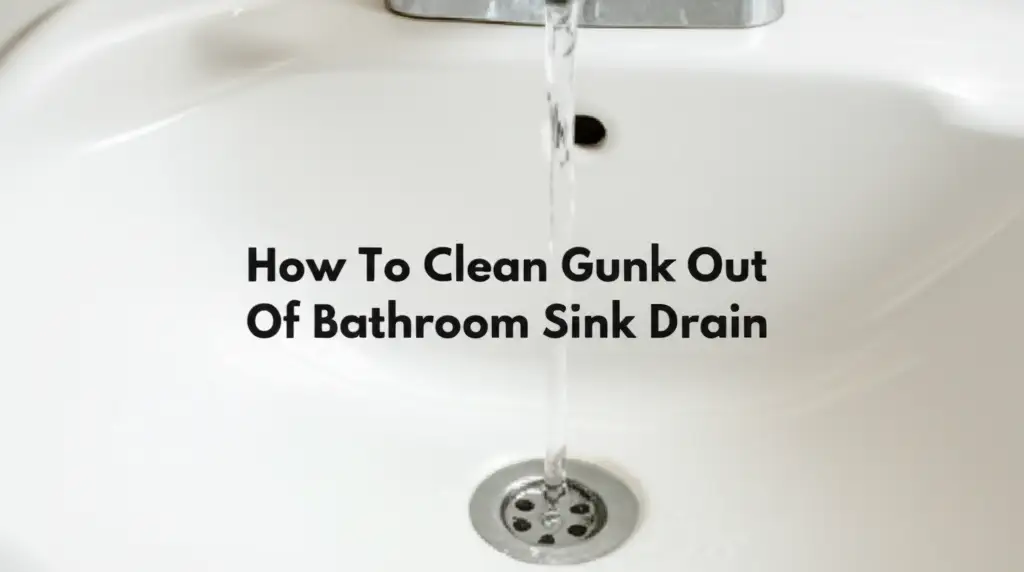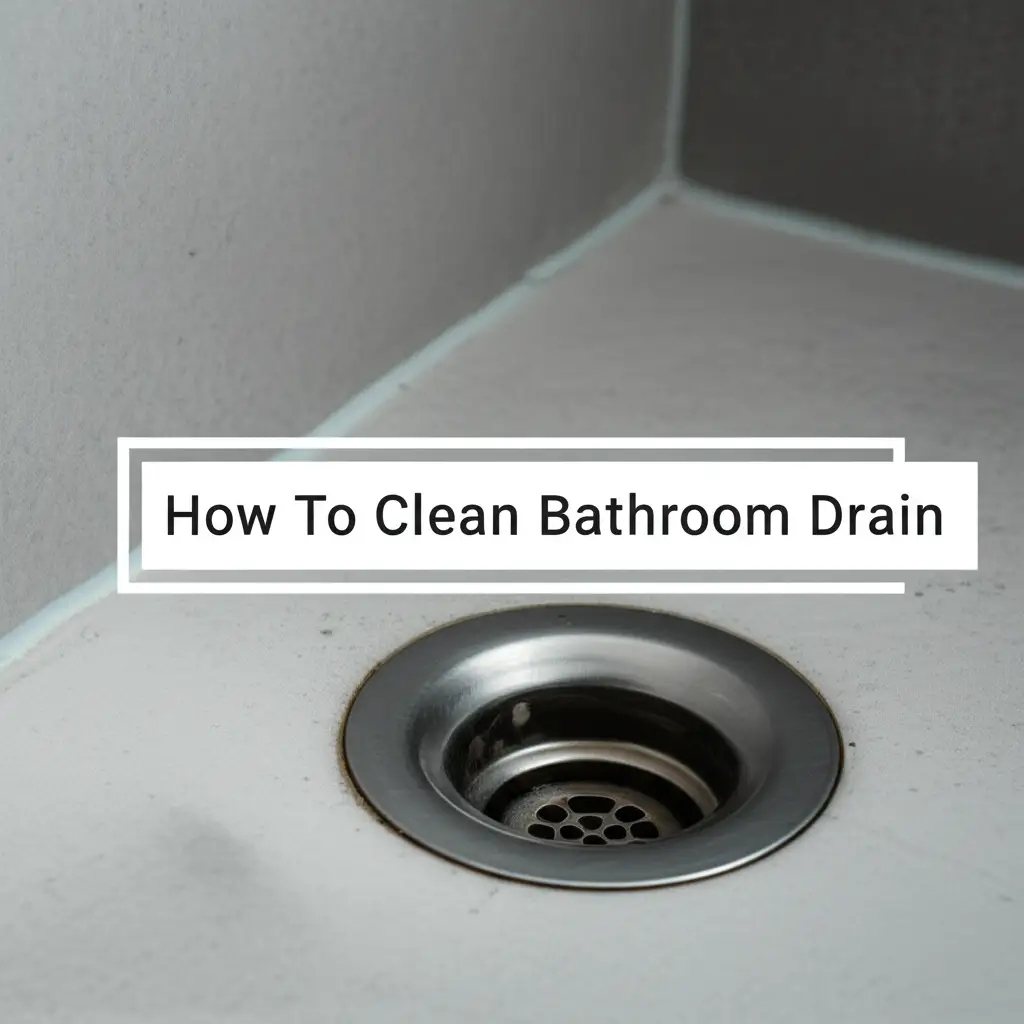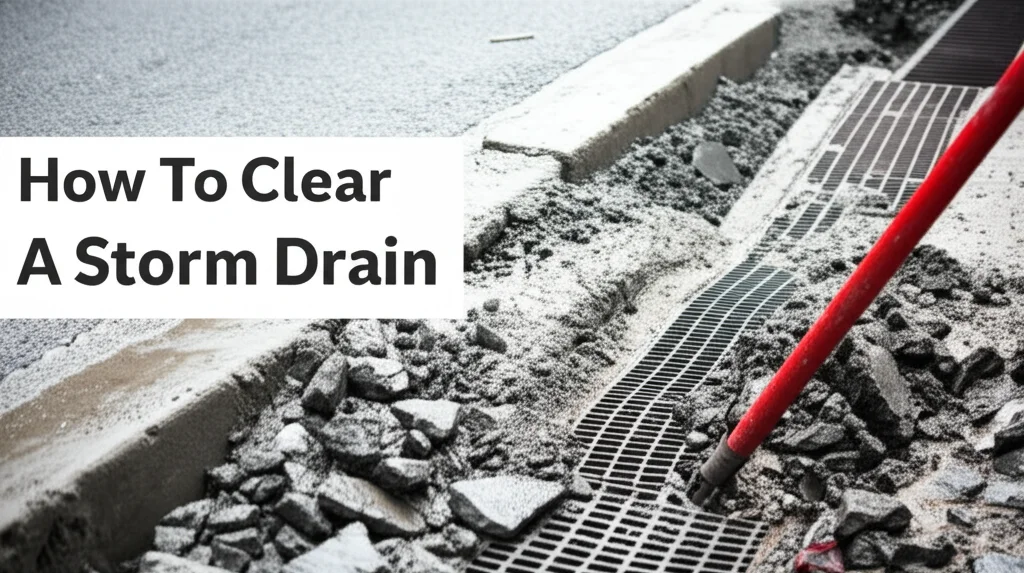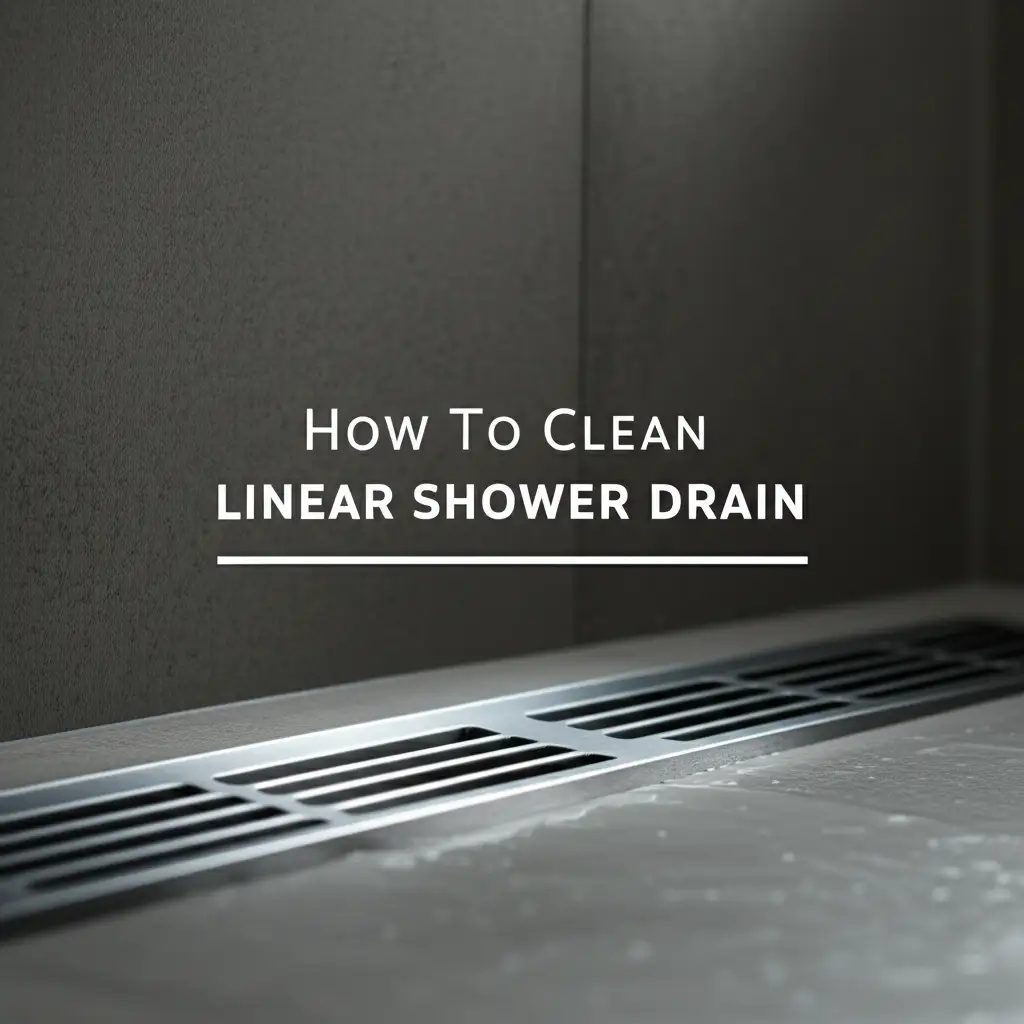· Home Maintenance · 16 min read
How To Clean Gunk Out Of Bathroom Sink Drain

Clean Gunk from Bathroom Sink Drain: A Comprehensive Guide
Has your bathroom sink started draining slowly? Do you notice a foul smell coming from the drain? This often points to a buildup of gunk. Hair, soap scum, toothpaste, and other debris combine to create stubborn clogs. These clogs block water flow and create unpleasant odors.
Learning how to clean gunk out of your bathroom sink drain is a key skill for any homeowner. It saves you money on plumber visits. It also keeps your bathroom fresh and functional. This article will show you various methods to tackle drain gunk. We will cover natural solutions, simple tools, and effective preventative steps. Get ready to enjoy a free-flowing sink once again.
Takeaway
- Identify the type and severity of your drain gunk.
- Start with simple, natural cleaning methods first.
- Use mechanical tools for stubborn hair clogs.
- Consider chemical or enzymatic cleaners with caution.
- Implement regular prevention habits to keep drains clear.
To clean gunk out of a bathroom sink drain, begin by removing the pop-up stopper to manually clear surface debris. Then, use natural solutions like baking soda and vinegar, or mechanical tools such as a drain snake. For tough clogs, a chemical cleaner might be necessary, but always follow safety instructions.
What is Gunk and Why Does It Form in Your Sink Drain?
Have you ever wondered what makes your bathroom sink drain so slow? The problem is often drain gunk. This sticky substance forms inside your pipes. It is a mix of common bathroom products and human waste.
Hair is a major part of this gunk. Each time you wash your hair, strands fall into the drain. These strands catch on rough spots inside the pipe. They act like a net.
Soap scum also adds to the problem. Bar soap contains fats that combine with minerals in water. This creates a sticky film. This film clings to the pipe walls. Toothpaste residue and skin flakes also wash down the drain. These tiny bits stick to the hair and soap scum. Over time, they create a solid mass. This mass restricts water flow. It also traps moisture and organic matter. This leads to bad smells. Understanding this helps you choose the right cleaning method. You are now ready to tackle the issue directly.
Essential Tools and Materials for Drain Cleaning
Before you start cleaning your bathroom sink drain, gather the right tools. Having everything ready makes the job easier and safer. You do not need many items for basic drain cleaning. Most are common household items.
First, you will need rubber gloves. These protect your hands from dirty water and cleaning agents. A bucket is also important. Place it under the P-trap to catch any water or debris during deeper cleaning. You will also need towels for spills.
For chemical-free methods, grab baking soda and white vinegar. These are safe and effective for many minor clogs. For mechanical cleaning, a plunger is a must-have. A drain snake, also called an auger, helps remove deep hair clogs. A Zip-It tool, a long plastic strip with barbs, is great for hair removal. Finally, a screwdriver helps remove the pop-up stopper or P-trap if needed. Having these items ready saves you time and effort. Essential Plumbing Tools for Homeowners can help you learn more about other useful tools.
Natural and Chemical-Free Drain Cleaning Methods
Starting with natural, chemical-free methods is always a good idea. These options are safe for your pipes and the environment. They often work well for common gunk blockages. You can usually find the ingredients in your kitchen.
Hot Water Flush
The simplest method is a hot water flush. Boil a kettle of water. Slowly pour the hot water down the drain. Do this in stages. Wait a few seconds between pours. Hot water can dissolve soap scum and greasy residue. It also loosens other soft blockages. This method works best for minor buildups. It also helps as a preventative measure.
Baking Soda and Vinegar Solution
This is a popular and effective DIY solution. First, pour half a cup of baking soda down the drain. Let it sit for a few minutes. Then, follow with half a cup of white vinegar. You will see fizzing and bubbling. This reaction helps break down the gunk. Place a stopper over the drain to contain the fizzing. Wait 30 minutes to an hour. Some people let it sit overnight. Afterward, flush the drain with hot water. Repeat if necessary. This method is great for smelly drains and light clogs. The Ultimate Guide to DIY Drain Cleaning Solutions provides more details on this.
Salt and Baking Soda Mix
Another natural option involves salt. Mix half a cup of baking soda with half a cup of salt. Pour this mixture down the drain. Add a cup or two of hot water. Let it sit for several hours or overnight. The salt helps to scour the pipe walls. The baking soda works to break down organic matter. Flush with hot water when done. This method is good for persistent odors and sticky residue. It is a simple step you can do often.
These natural methods are safe and easy to try first. They are often enough to clear many bathroom sink clogs. If these methods do not work, you can try stronger solutions.
Mechanical Drain Clearing Techniques
When natural methods do not clear the gunk, mechanical tools are your next step. These tools physically remove the blockage. They are especially useful for hair clogs. Hair is often the main culprit in bathroom sink drains.
Using a Plunger Effectively
A plunger is a simple but powerful tool. Make sure you use a cup-style plunger, not a toilet plunger. First, remove the pop-up stopper from your sink. Fill the sink with enough water to cover the plunger cup. This creates a good seal. Place the plunger firmly over the drain opening. Pump the plunger up and down vigorously for 15-20 seconds. Maintain the seal. On the last pull, break the seal quickly. This suction and pressure can dislodge the clog. Repeat this process a few times. Flush with water to check if the drain is clear. This method often works for clogs near the drain opening.
Employing a Drain Snake or Auger
For deeper and more stubborn clogs, a drain snake is very effective. A drain snake is a long, flexible metal coil. It has a crank handle. Push the end of the snake into the drain opening. Feed it slowly down the pipe. Turn the crank handle as you go. You will feel resistance when you hit the clog. Keep turning and pushing. The snake’s end will break apart the clog or hook onto it. Pull the snake back out slowly. You will likely pull out a mass of hair and gunk. Be ready to clean the snake as you pull it out. Repeat the process if needed. Flush with hot water to clear any remaining debris. Drain snakes can reach clogs far down the pipe.
The Zip-It Tool Method
The Zip-It tool is a plastic strip with barbs along its sides. It is a disposable and inexpensive option. It works very well for hair clogs. Remove your pop-up stopper first. Push the Zip-It tool down into the drain. Push it as far as it can go. Then, slowly pull it back up. The barbs will grab onto hair and other gunk. You will likely pull out a disgusting amount of hair. Dispose of the gunk and the tool properly. Repeat this a few times until the drain runs clear. This tool is quick and easy to use. It is perfect for surface hair clogs. Mechanical tools are often the most direct way to remove stubborn blockages. They provide immediate results.
Deep Cleaning: Removing the Pop-Up Stopper and P-Trap
Sometimes, the gunk is too far down or too dense for simple methods. You may need to access the drain physically. This involves removing parts of your sink’s plumbing. Do not worry, it is a straightforward process.
Cleaning the Pop-Up Stopper
The pop-up stopper is usually the first place gunk collects. This is the stopper you lift or push to open and close the drain. To clean it, you need to remove it. Look under the sink. You will find a pivot rod that connects to the stopper. It usually has a nut holding it in place. Loosen this nut and pull the rod out. Then, lift the pop-up stopper out from the top of the sink. It will likely be covered in hair and slime. Use a paper towel or old brush to clean all the gunk off. Rinse it thoroughly. Put the stopper back in. Reinsert the pivot rod and tighten the nut. Test the stopper to ensure it moves freely. This simple step often clears minor to moderate clogs.
Clearing the P-Trap
If cleaning the stopper does not work, the clog is likely in the P-trap. This is the U-shaped pipe under your sink. It traps water to prevent sewer gases from entering your home. It also catches heavier debris. First, place a bucket directly under the P-trap. This catches water and debris. Use channel locks or a wrench to loosen the slip nuts on both ends of the P-trap. These nuts connect the P-trap to the drainpipe and the wall pipe. Carefully remove the P-trap. Water will spill out, so be ready.
Once removed, clean the inside of the P-trap. Use an old brush or a coat hanger to push out any gunk. Rinse the P-trap thoroughly with hot water. Check for any remaining blockages. Before reattaching, inspect the washers inside the slip nuts. Replace them if they are worn out. Position the P-trap correctly. Tighten the slip nuts by hand, then a quarter turn with your wrench. Do not overtighten. Turn on the water slowly. Check for any leaks. This method clears most stubborn clogs. It gives you direct access to the most common clog spot. Maintaining Your Bathroom Fixtures discusses other parts of your bathroom plumbing.
When to Consider Chemical or Enzymatic Drain Cleaners
Chemical and enzymatic drain cleaners offer a different approach to clearing clogs. They use specific formulas to break down organic matter. These products can be powerful, but you must use them with caution.
Understanding Chemical Drain Cleaners
Chemical drain cleaners usually contain strong alkalis or acids. They work by creating a chemical reaction. This reaction generates heat, which helps dissolve grease and hair. For example, some contain lye (sodium hydroxide). Others might use sulfuric acid. These chemicals are corrosive. They can cause skin burns or eye damage. Always wear protective gloves and eyewear when using them. Ensure the bathroom is well-ventilated. Never mix different chemical drain cleaners. This can create dangerous fumes. Pour the product carefully into the drain. Follow the instructions on the label exactly. Allow the specified time for it to work. Then, flush with cold water. Chemical cleaners should be a last resort. Repeated use can damage pipes, especially older ones. They are not ideal for preventing future clogs.
Exploring Enzymatic Drain Cleaners
Enzymatic drain cleaners work differently. They contain live bacteria or enzymes. These biological agents “eat” away at organic material like hair, soap, and food particles. They do not use harsh chemicals. This makes them safer for your pipes and the environment. They work slowly. You often need to apply them overnight. They are effective for maintenance and preventing minor clogs. Enzymatic cleaners do not generate heat. They will not damage your pipes. They are also safe for septic systems. However, they are not good for fully blocked drains. They work best for slow drains or as a preventative measure. You can use them regularly to keep drains clear. Choose the right cleaner for your specific situation. Safety is always important when using any drain product.
Preventative Measures: Keeping Your Bathroom Sink Drain Gunk-Free
Preventing clogs is always better than fixing them. A few simple habits can keep your bathroom sink drain clear. These steps save you time and effort in the long run. They also protect your plumbing.
Using a Drain Strainer
The easiest way to prevent gunk is to catch it before it goes down the drain. Install a drain strainer in your bathroom sink. These are small mesh screens or cups. They sit over the drain opening. They catch hair, soap bits, and other debris. Clean the strainer regularly. Simply lift it out and remove the caught materials. Dispose of them in the trash. This simple barrier stops most common clog-causing items. It is an inexpensive and highly effective preventative measure.
Regular Hot Water Flushes
Make it a habit to flush your drain with hot water. After brushing your teeth or washing your face, let the hot water run for a minute. You can also pour a kettle of hot water down the drain weekly. This helps to melt away minor grease buildup and soap scum. It keeps the inside of the pipes cleaner. Hot water flushes are easy to do. They do not require any special products. This simple action prevents small problems from becoming big ones.
Baking Soda and Vinegar Maintenance
Regular use of baking soda and vinegar can keep drains fresh. Do this once a month. Pour half a cup of baking soda down the drain. Follow with half a cup of white vinegar. Let it sit for 30 minutes. Then, flush with hot water. This mixture helps break down minor buildups. It also neutralizes odors. This method is safe for your pipes. It is also good for the environment. It acts as a proactive cleaner. Simple Steps to Prevent Drain Clogs offers more tips on this.
Avoid Disposing of Certain Items
Be mindful of what goes down your drain. Hair is the biggest problem. Try to brush hair out of your brush before washing it. Dispose of hair directly in the trash. Never pour grease or oils down the bathroom sink. While uncommon in bathrooms, these solidify and cause clogs. Avoid pouring harsh chemicals like paint thinner down the drain. These damage pipes and pollute water. Only allow water and approved liquid waste down the drain. Being careful with disposal habits makes a big difference.
Scheduled Professional Inspections
Even with the best preventative measures, sometimes issues arise. Consider scheduling a professional plumbing inspection every few years. A plumber can identify potential problems before they become major clogs. They can also perform deep cleaning or snaking if necessary. This proactive step ensures your plumbing system remains in good condition. It provides peace of mind. Regular maintenance prevents expensive emergency repairs.
When to Call a Professional Plumber
While many drain issues are DIY-friendly, some clogs need a professional. Knowing when to call a plumber saves you time, effort, and potential damage. Do not hesitate if you face specific challenges.
First, if you have tried several methods and the clog remains, it is time for a professional. A plumber has specialized tools like powerful augers. They also have cameras to inspect deep within pipes. These tools can find and clear blockages you cannot reach. Second, if you notice multiple drains in your home are clogged, this indicates a bigger issue. A main sewer line blockage affects all drains. This requires professional intervention. Trying to fix it yourself can make the problem worse.
Third, persistent bad odors that do not go away with cleaning suggest an underlying problem. This could be trapped waste or a broken vent pipe. A plumber can diagnose the source of the smell. Finally, if you hear gurgling sounds from other drains when using one, this signals air pressure issues. It might be related to your venting system. This is a job for a licensed plumber. Do not risk damaging your pipes or causing water leaks. Professional plumbers have the expertise to fix complex issues safely. When to Call a Professional Plumber gives further details on this topic.
FAQ Section
Q1: How often should I clean my bathroom sink drain? A1: You should clean your bathroom sink drain every 1-3 months. This helps prevent major clogs. Regular hot water flushes or baking soda and vinegar treatments are good for routine maintenance. If you notice slow draining or odors, clean it sooner. Consistent care keeps your pipes clear.
Q2: Can I use boiling water to clear a PVC pipe drain? A2: Using boiling water directly on PVC pipes is generally not recommended. Extreme heat can soften or warp PVC pipes. This can lead to leaks or damage. Instead, use very hot tap water for flushing. Or, let boiled water cool for a few minutes before pouring it down. This is safer for plastic pipes.
Q3: What is the best way to get rid of drain odors? A3: The best way to get rid of drain odors is to clean the gunk causing them. Use baking soda and vinegar. Let it sit overnight, then flush with hot water. You can also pour half a cup of bleach down the drain (if safe for your pipes) followed by water. Ensure good ventilation. A clean drain will not smell bad.
Q4: Is it safe to use chemical drain cleaners often? A4: No, it is not safe to use chemical drain cleaners often. These products are harsh. They can damage your pipes over time. They are corrosive and pose safety risks. Use them only as a last resort for severe clogs. Always follow safety instructions. Prefer natural or mechanical methods for regular maintenance.
Q5: My drain is completely blocked. What should I do first? A5: If your drain is completely blocked, first try a plunger. If that does not work, try removing and cleaning the pop-up stopper. Next, use a drain snake or Zip-It tool. If none of these methods work, the clog is likely deep. Call a professional plumber for assistance. Do not force chemicals down a completely blocked drain.
Q6: Can hair dissolvers really clean hair clogs? A6: Hair dissolvers can work on hair clogs. They contain strong chemicals that break down hair. However, they may not remove all gunk. They can also harm pipes if left too long. Many people prefer mechanical methods like a drain snake. These physically remove the hair. Use hair dissolvers with caution.
Conclusion
Cleaning gunk out of your bathroom sink drain does not have to be a difficult chore. You now have several effective methods at your disposal. From simple hot water flushes to using a drain snake, each technique helps clear away stubborn clogs. Remember to start with the least invasive methods, like baking soda and vinegar. Move to mechanical tools or chemical solutions only if necessary.
The key to a consistently clear drain is prevention. By regularly using a drain strainer, doing hot water flushes, and being mindful of what goes down the drain, you can significantly reduce gunk buildup. Taking these steps keeps your bathroom sink drain flowing freely. It helps avoid unpleasant odors and costly plumbing issues. Keep your pipes happy and your home clean by taking proactive action today. A clean drain means a clean home.
- clogged drain
- sink cleaning
- drain maintenance
- bathroom plumbing




